

Compact Muon Solenoid
LHC, CERN
| CMS-EXO-17-006 ; CERN-EP-2017-194 | ||
| Search for evidence of the type-III seesaw mechanism in multilepton final states in proton-proton collisions at $ \sqrt{s} = $ 13 TeV | ||
| CMS Collaboration | ||
| 25 August 2017 | ||
| Phys. Rev. Lett. 119 (2017) 221802 | ||
| Abstract: A search for a signal consistent with the type-III seesaw mechanism in events with three or more electrons or muons is presented. The data sample consists of proton-proton collisions at $ \sqrt{s} = $ 13 TeV collected by the CMS experiment at the LHC in 2016 and corresponds to an integrated luminosity of 35.9 fb$^{-1}$. Selection criteria based on the number of leptons and the invariant mass of opposite-sign lepton pairs are used to distinguish the signal from the standard model background. The observations are consistent with the expectations from standard model processes. The results are used to place limits on the production of heavy fermions of the type-III seesaw model as a function of the branching ratio to each lepton flavor. In the scenario of equal branching fractions to each lepton flavor, heavy fermions with masses below 840 GeV are excluded. This is the most sensitive probe to date of the type-III seesaw mechanism. | ||
| Links: e-print arXiv:1708.07962 [hep-ex] (PDF) ; CDS record ; inSPIRE record ; CADI line (restricted) ; | ||
| Figures & Tables | Summary | Additional Figures & Tables | References | CMS Publications |
|---|
| Figures | |
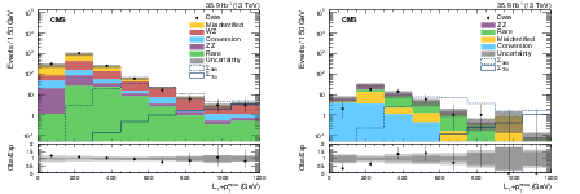
png pdf |
Figure 1:
The $ {L_\mathrm {T}} + { {p_{\mathrm {T}}} ^\text {miss}} $ distribution for events with three leptons and one OSSF pair with mass above-Z (left) and the $ {L_\mathrm {T}} + { {p_{\mathrm {T}}} ^\text {miss}} $ distribution for events with four or more leptons and one OSSF pair (right). The total SM background is shown as a stacked histogram of all contributing processes. The predictions for signal models (sum of all production and decay modes) with $m_{\Sigma } = $ 700 GeV (solid line) and $m_{\Sigma } = $ 380 GeV (dashed line) are also shown. The lower panels show the ratio of observed to expected events. The hatched gray band in the upper panel, and the dark and light gray bands in the lower panel represent the total, statistical, and systematic uncertainties in the expected background, respectively. |
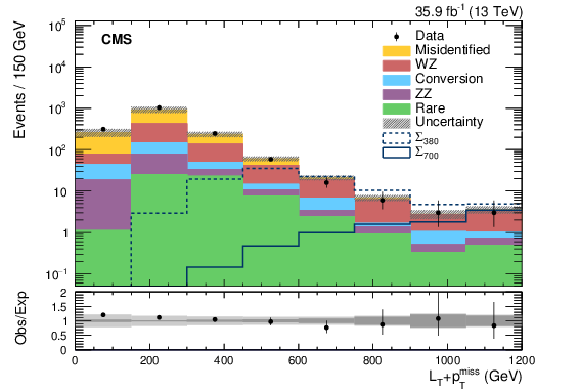
png pdf |
Figure 1-a:
The $ {L_\mathrm {T}} + { {p_{\mathrm {T}}} ^\text {miss}} $ distribution for events with three leptons and one OSSF pair with mass above-Z. The total SM background is shown as a stacked histogram of all contributing processes. The predictions for signal models (sum of all production and decay modes) with $m_{\Sigma } = $ 700 GeV (solid line) and $m_{\Sigma } = $ 380 GeV (dashed line) are also shown. The lower panel shows the ratio of observed to expected events. The hatched gray band in the upper panel, and the dark and light gray bands in the lower panel represent the total, statistical, and systematic uncertainties in the expected background, respectively. |

png pdf |
Figure 1-b:
The $ {L_\mathrm {T}} + { {p_{\mathrm {T}}} ^\text {miss}} $ distribution for events with four or more leptons and one OSSF pair. The total SM background is shown as a stacked histogram of all contributing processes. The predictions for signal models (sum of all production and decay modes) with $m_{\Sigma } = $ 700 GeV (solid line) and $m_{\Sigma } = $ 380 GeV (dashed line) are also shown. The lower panel shows the ratio of observed to expected events. The hatched gray band in the upper panel, and the dark and light gray bands in the lower panel represent the total, statistical, and systematic uncertainties in the expected background, respectively. |

png pdf |
Figure 2:
The 95% confidence level upper limits on the cross section for production of heavy fermion pairs ($\Sigma^{0} \Sigma^{+} $, $\Sigma^{0} \Sigma^{-} $, and $\Sigma^{+} \Sigma^{-} $). Also shown is the theoretical prediction for the cross section of the $ \Sigma $ pair production via the type III seesaw mechanism, with its uncertainty. In the flavor-democratic scenario ($B_\mathrm{ e } =B_\mu =B_\tau $), heavy fermion pair production is excluded for masses below 840 GeV. |

png pdf |
Figure 3:
The 95% confidence level expected (left) and observed (right) limits on the heavy fermion mass ${m_\Sigma }$ (GeV) for each combination of branching fractions to the individual lepton flavors. The color scale represents the mass exclusion limit obtained at each point. The branching fraction to $\mu $ can be obtained from $B_{\mu }=1- [B_{\mathrm{ e } } + B_{\tau }]$. The highlighted box indicates the limit on $m_{\Sigma }$ for the flavor-democratic scenario ($B_\mathrm{ e } =B_\mu =B_\tau $). |
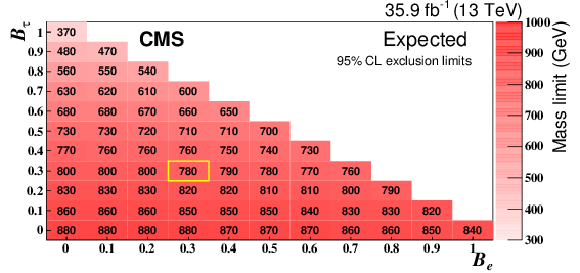
png pdf |
Figure 3-a:
The 95% confidence level expected limits on the heavy fermion mass ${m_\Sigma }$ (GeV) for each combination of branching fractions to the individual lepton flavors. The color scale represents the mass exclusion limit obtained at each point. The branching fraction to $\mu $ can be obtained from $B_{\mu }=1- [B_{\mathrm{ e } } + B_{\tau }]$. The highlighted box indicates the limit on $m_{\Sigma }$ for the flavor-democratic scenario ($B_\mathrm{ e } =B_\mu =B_\tau $). |
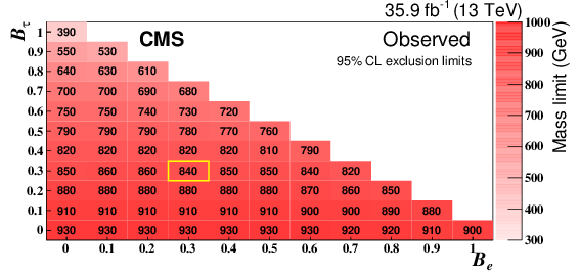
png pdf |
Figure 3-b:
The 95% confidence level observed limits on the heavy fermion mass ${m_\Sigma }$ (GeV) for each combination of branching fractions to the individual lepton flavors. The color scale represents the mass exclusion limit obtained at each point. The branching fraction to $\mu $ can be obtained from $B_{\mu }=1- [B_{\mathrm{ e } } + B_{\tau }]$. The highlighted box indicates the limit on $m_{\Sigma }$ for the flavor-democratic scenario ($B_\mathrm{ e } =B_\mu =B_\tau $). |
| Tables | |
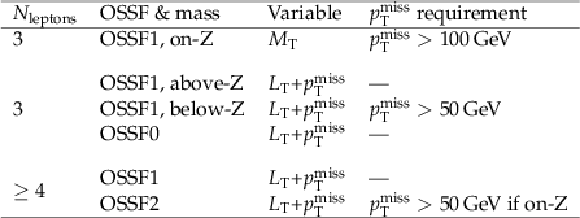
png pdf |
Table 1:
The signal regions summarized in terms of the number of leptons, the presence of an OSSF pair, and the kinematic variable used for signal discrimination. Each region is divided into eight bins in the kinematic variable, leading to 48 independent signal regions. Additional criteria based on $ { {p_{\mathrm {T}}} ^\text {miss}} $ ensure that signal and control regions do not overlap. |
| Summary |
| In summary, a search has been performed for type-III seesaw heavy fermions in multilepton final states using 35.9 fb$^{-1}$ of pp collision data at $ \sqrt{s} = $ 13 TeV, collected using the CMS detector. No significant discrepancies are observed between the data and the standard model prediction. Assuming degenerate heavy fermion masses, previously unexplored regions of the signal model as a function of the branching ratio of heavy fermions to each lepton flavor are excluded. In the lepton-flavor democratic scenario ($B_\mathrm{ e } =B_\mu =B_\tau $), heavy fermions with mass below 840 GeV are excluded at 95% confidence level. In the $\tau$-phobic case ($B_\mathrm{ e } =B_\mu =B_\tau $) the mass limits range from 900 GeV in the pure electron scenario to 930 GeV in the pure muon scenario. In the e/$\mu$-phobic case ($B_\tau =$ 1, $ B_\mathrm{e} + B_\mu =$ 0) the mass limit is 390 GeV. These are the strongest constraints to date on the mass of heavy fermions associated with the type-III seesaw mechanism. |
| Additional Figures | |

png pdf |
Additional Figure 1:
The $ {M_\mathrm {T}} $ distribution for events with three leptons, one OSSF pair with mass on-Z, and $ {{p_{\mathrm {T}}} ^\text {miss}} > $ 100 GeV. The total SM background is shown as a stacked histogram of all contributing processes. The predictions for signal models (sum of all production and decay modes) with $m_{\Sigma} = $ 700 GeV (solid line) and $m_{\Sigma} = $ 380 GeV (dashed line) are also shown. The lower panel shows the ratio of observed to expected events. The hatched gray band in the upper panel, and the dark and light gray bands in the lower panel represent the total, statistical, and systematic uncertainties in the expected background, respectively. |
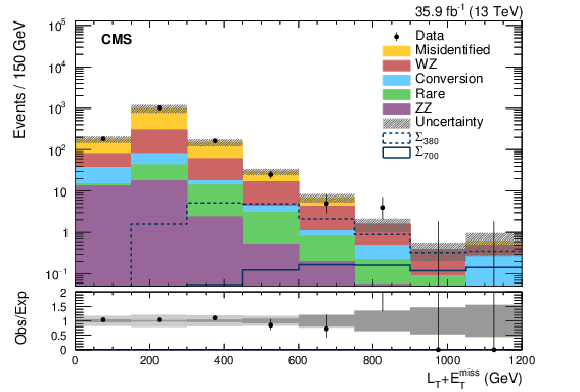
png pdf |
Additional Figure 2:
The $ {L_\mathrm {T}} + {{p_{\mathrm {T}}} ^\text {miss}} $ distribution for events with three leptons, one OSSF pair with mass below-Z, and $ {{p_{\mathrm {T}}} ^\text {miss}} > $ 50 GeV. The total SM background is shown as a stacked histogram of all contributing processes. The predictions for signal models (sum of all production and decay modes) with $m_{\Sigma} = $ 700 GeV (solid line) and $m_{\Sigma} = $ 380 GeV (dashed line) are also shown. The lower panel shows the ratio of observed to expected events. The hatched gray band in the upper panel, and the dark and light gray bands in the lower panel represent the total, statistical, and systematic uncertainties in the expected background, respectively. |
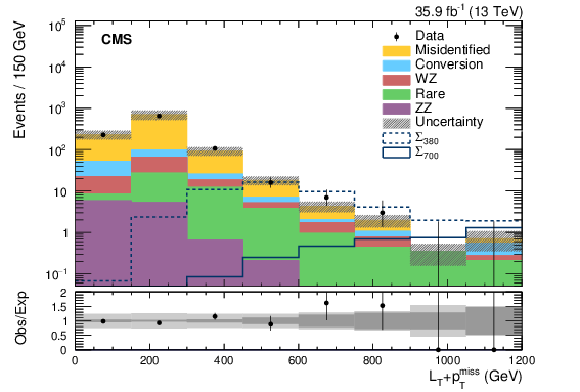
png pdf |
Additional Figure 3:
The $ {L_\mathrm {T}} + {{p_{\mathrm {T}}} ^\text {miss}} $ distribution for events with three leptons and no OSSF pair. The total SM background is shown as a stacked histogram of all contributing processes. The predictions for signal models (sum of all production and decay modes) with $m_{\Sigma} = $ 700 GeV (solid line) and $m_{\Sigma} = $ 380 GeV (dashed line) are also shown. The lower panel shows the ratio of observed to expected events. The hatched gray band in the upper panel, and the dark and light gray bands in the lower panel represent the total, statistical, and systematic uncertainties in the expected background, respectively. |

png pdf |
Additional Figure 4:
The $ {L_\mathrm {T}} + {{p_{\mathrm {T}}} ^\text {miss}} $ distribution for events with four or more leptons and two or more OSSF pairs. If one OSSF pair is on-Z, then $ {{p_{\mathrm {T}}} ^\text {miss}} > $ 50 GeV is required. The total SM background is shown as a stacked histogram of all contributing processes. The predictions for signal models (sum of all production and decay modes) with $m_{\Sigma} = $ 700 GeV (solid line) and $m_{\Sigma} = $ 380 GeV (dashed line) are also shown. The lower panel shows the ratio of observed to expected events. The hatched gray band in the upper panel, and the dark and light gray bands in the lower panel represent the total, statistical, and systematic uncertainties in the expected background, respectively. |
| Additional Tables | |

png pdf |
Additional Table 1:
Observed and expected number of events with 3 and 4 or more leptons in the 48 signal regions, classified by the number of leptons, the presence and the mass of an OSSF pair, and $ {L_\mathrm {T}} + {{p_{\mathrm {T}}} ^\text {miss}} $ or $ {M_\mathrm {T}} $. The uncertainties quoted on the expected number of background events include statistical and systematic uncertainties. |
| References | ||||
| 1 | F. Capozzi et al. | Status of three-neutrino oscillation parameters, circa 2013 | PRD 89 (2014) 093018 | 1312.2878 |
| 2 | P. Minkowski | $ {\mu} \to {\mathrm{ e }} \gamma $ at a rate of one out of $ 10^9 $ muon decays? | PLB 67 (1977) 421 | |
| 3 | R. N. Mohapatra, N. Rabindra, and G. Senjanovic | Neutrino mass and spontaneous parity violation | PRL 44 (1980) 912 | |
| 4 | M. Magg and C. Wetterich | Neutrino mass problem and gauge hierarchy | PRB 94 (1980) 61 | |
| 5 | R. N. Mohapatra and G. Senjanovic | Neutrino masses and mixings in gauge models with spontaneous parity violation | PRD 23 (1981) 165 | |
| 6 | J. Schechter and J. W. F. Valle | Neutrino masses in $ \mathrm{ SU(2) {\otimes} U(1) } $ theories | PRD 22 (1980) 2227 | |
| 7 | J. Schechter and J. W. F. Valle | Neutrino decay and spontaneous violation of lepton number | PRD 25 (1982) 774 | |
| 8 | R. Foot, H. Lew, X. G. He, and G. C. Joshi | See-saw neutrino masses induced by a triplet of leptons | Z. Phys. C 44 (1989) 441 | |
| 9 | R. N. Mohapatra | Mechanism for understanding small neutrino mass in superstring theories | PRL 56 (1986) 561 | |
| 10 | R. N. Mohapatra and J. W. F. Valle | Neutrino mass and baryon-number nonconservation in superstring models | PRD 34 (1986) 1642 | |
| 11 | W. Wang and Z.-L. Han | Naturally small Dirac neutrino mass with intermediate $ SU(2)_{L} $ multiplet fields | JHEP 04 (2016) 166 | 1611.03240 |
| 12 | T. Li and X.-G. He | Neutrino masses and heavy triplet leptons at the LHC: Testability of type III seesaw | PRD 80 (2009) 093003 | 0907.4193 |
| 13 | F. F. Deppisch, P. S. Bhupal Dev, and A. Pilaftsis | Neutrinos and collider physics | New J. Phys. 17 (2015) 075019 | 1502.06541 |
| 14 | P. Fileviez Perez | Type III seesaw and left-right symmetry | JHEP 03 (2009) 142 | 0809.1202 |
| 15 | A. Arhrib et al. | Collider signatures for the heavy lepton triplet in the type I+III seesaw mechanism | PRD 82 (2010) 053004 | 0904.2390 |
| 16 | F. del Aguila and J. A. Aguilar-Saavedra | Electroweak scale seesaw and heavy Dirac neutrino signals at LHC | PLB 672 (2009) 158 | 0809.2096 |
| 17 | R. Franceschini, T. Hambye, and A. Strumia | Type-III seesaw mechanism at CERN LHC | PRD 78 (2008) 033002 | 0805.1613 |
| 18 | K. L. McDonald | Probing exotic fermions from a seesaw/radiative model at the LHC | JHEP 11 (2013) 131 | 1310.0609 |
| 19 | R. Ding et al. | Phenomenology in the minimal cascade seesaw mechanism for neutrino masses | PRD 89 (2014) 115024 | 1403.2040 |
| 20 | F. del Aguila and J. A. Aguilar-Saavedra | Distinguishing seesaw models at LHC with multi-lepton signals | NPB 813 (2009) 22 | 0808.2468 |
| 21 | F. del Aguila, J. A. Aguilar-Saavedra, and J. de Blas | Trilepton signals: the golden channel for seesaw searches at LHC | in Proceedings, 33rd International Conference of Theoretical Physics, Matter to the Deepest, Poland, 2009 [Acta Phys. Polon. B 40 (2009) 2901] | 0910.2720 |
| 22 | C. Biggio and F. Bonnet | Implementation of the Type III seesaw model in FeynRules/MadGraph and prospects for discovery with early LHC data | EPJC 72 (2012) 1899 | 1107.3463 |
| 23 | CMS Collaboration | Search for heavy lepton partners of neutrinos in proton-proton collisions in the context of the type III seesaw mechanism | PLB 718 (2012) 348 | CMS-EXO-11-073 1210.1797 |
| 24 | ATLAS Collaboration | Search for type-III seesaw heavy leptons in $ pp $ collisions at $ \sqrt{s} = $ 8 TeV with the ATLAS detector | PLD 92 (2015) 032001 | 1506.01839 |
| 25 | CMS Collaboration | The CMS experiment at the CERN LHC | JINST 3 (2008) S08004 | CMS-00-001 |
| 26 | CMS Collaboration | The CMS trigger system | JINST 12 (2017) P01020 | CMS-TRG-12-001 1609.02366 |
| 27 | J. Alwall et al. | MadGraph 5: Going Beyond | JHEP 06 (2011) 128 | 1106.0522 |
| 28 | J. Alwall et al. | The automated computation of tree-level and next-to-leading order differential cross sections, and their matching to parton shower simulations | JHEP 07 (2014) 079 | 1405.0301 |
| 29 | NNPDF Collaboration | Parton distributions for the LHC Run II | JHEP 04 (2015) 040 | 1410.8849 |
| 30 | B. Fuks, M. Klasen, D. R. Lamprea, and M. Rothering | Gaugino production in proton-proton collisions at a center-of-mass energy of 8 TeV | JHEP 10 (2012) 081 | 1207.2159 |
| 31 | B. Fuks, M. Klasen, D. R. Lamprea, and M. Rothering | Precision predictions for electroweak superpartner production at hadron colliders with Resummino | EPJC 73 (2013) 2480 | 1304.0790 |
| 32 | P. Nason | A new method for combining NLO QCD with shower Monte Carlo algorithms | JHEP 11 (2004) 040 | hep-ph/0409146 |
| 33 | S. Frixione, P. Nason, and C. Oleari | Matching NLO QCD computations with parton shower simulations: the POWHEG method | JHEP 11 (2007) 070 | 0709.2092 |
| 34 | S. Alioli, P. Nason, C. Oleari, and E. Re | A general framework for implementing NLO calculations in shower Monte Carlo programs: the POWHEG BOX | JHEP 06 (2010) 043 | 1002.2581 |
| 35 | Y. Gao et al. | Spin determination of single-produced resonances at hadron colliders | PRD 81 (2010) 075022 | 1001.3396 |
| 36 | S. Bolognesi et al. | On the spin and parity of a single-produced resonance at the LHC | PRD 86 (2012) 095031 | 1208.4018 |
| 37 | I. Anderson et al. | Constraining anomalous $ HVV $ interactions at proton and lepton colliders | PRD 89 (2014) 035007 | 1309.4819 |
| 38 | A. V. Gritsan, R. Rontsch, M. Schulze, and M. Xiao | Constraining anomalous Higgs boson couplings to the heavy flavor fermions using matrix element techniques | PRD 94 (2016) 055023 | 1606.03107 |
| 39 | T. Sjostrand, S. Mrenna, and P. Z. Skands | PYTHIA 6.4 physics and manual | JHEP 05 (2006) 026 | hep-ph/0603175 |
| 40 | T. Sjostrand et al. | An introduction to PYTHIA 8.2 | CPC 191 (2015) 159 | 1410.3012 |
| 41 | GEANT4 Collaboration | GEANT4---a simulation toolkit | NIMA 506 (2003) 250 | |
| 42 | CMS Collaboration | Pileup removal algorithms | CMS-PAS-JME-14-001 | CMS-PAS-JME-14-001 |
| 43 | CMS Collaboration | Performance of electron reconstruction and selection with the CMS detector in proton-proton collisions at $ \sqrt{s} = $ 8 TeV | JINST 10 (2015) P06005 | CMS-EGM-13-001 1502.02701 |
| 44 | CMS Collaboration | Particle-flow reconstruction and global event description with the CMS detector | Submitted to JINST | CMS-PRF-14-001 1706.04965 |
| 45 | CMS Collaboration | Particle-Flow Event Reconstruction in CMS and Performance for Jets, Taus, and MET | CMS-PAS-PFT-09-001 | |
| 46 | M. Cacciari, G. P. Salam, and G. Soyez | The anti-$ k_t $ jet clustering algorithm | JHEP 04 (2008) 063 | 0802.1189 |
| 47 | CMS Collaboration | Performance of the CMS missing transverse momentum reconstruction in pp data at $ \sqrt{s} = $ 8 TeV | JINST 10 (2015) P02006 | CMS-JME-13-003 1411.0511 |
| 48 | M. Cacciari, G. P. Salam, and G. Soyez | FastJet user manual | EPJC 72 (2012) 1896 | 1111.6097 |
| 49 | CMS Collaboration | Measurement of the $ \mathrm{t}\overline{\mathrm{t}} $ production cross section in the dilepton channel in pp collisions at $ \sqrt{s}= $ 7 TeV | JHEP 11 (2012) 067 | CMS-TOP-11-005 1208.2671 |
| 50 | J. Butterworth et al. | PDF4LHC recommendations for LHC Run II | JPG 43 (2016) 023001 | 1510.03865 |
| 51 | T. Junk | Confidence level computation for combining searches with small statistics | Nucl. Inst. Meth. A 434 (1999) 435 | hep-ex/9902226 |
| 52 | A. L. Read | Presentation of search results: the $ CL_s $ technique | in Durham IPPP Workshop: Advanced Statistical Techniques in Particle Physics, p. 2693 Durham, UK, March, 2002 [JPG 28 (2002) 2693] | |
| 53 | ATLAS and CMS Collaborations | Procedure for the LHC Higgs boson search combination in summer 2011 | CMS NOTE-2011/005, ATL-PHYS-PUB-2011-11 | |
| 54 | G. Cowan, K. Cranmer, E. Gross, and O. Vitells | Asymptotic formulae for likelihood-based tests of new physics | EPJC 71 (2011) 1554 | 1007.1727 |

|
Compact Muon Solenoid LHC, CERN |

|

|

|

|

|

|